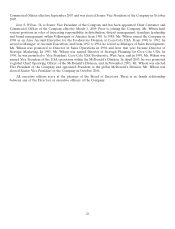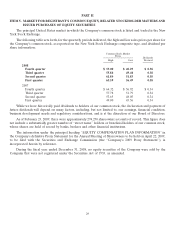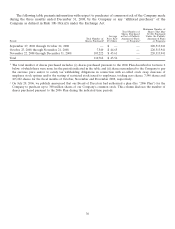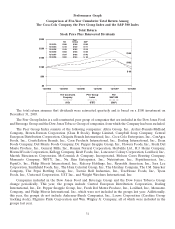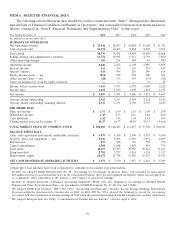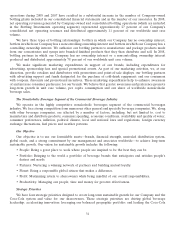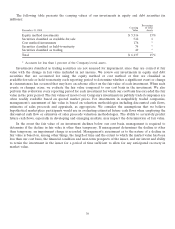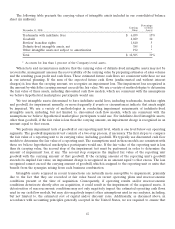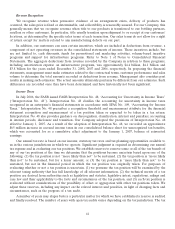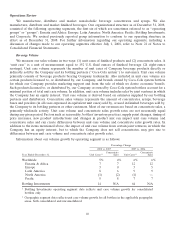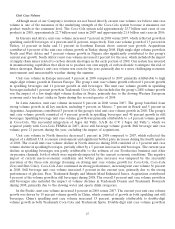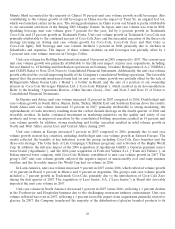Coca Cola 2008 Annual Report Download - page 40
Download and view the complete annual report
Please find page 40 of the 2008 Coca Cola annual report below. You can navigate through the pages in the report by either clicking on the pages listed below, or by using the keyword search tool below to find specific information within the annual report.No. 159, ‘‘The Fair Value Option for Financial Assets and Financial Liabilities—Including an amendment of
FASB Statement No. 115,’’ which provides entities the option to measure many financial instruments and certain
other items at fair value. Investments in equity securities that do not qualify for fair value accounting, or for
which the Company has not elected the fair value option, are accounted for under the cost method. In
accordance with the cost method, our initial investment is recorded at cost and we record dividend income when
applicable dividends are declared. Cost method investments are reported as other investments in our
consolidated balance sheets.
Our Company eliminates all significant intercompany transactions, including the intercompany portion of
transactions with equity method investees, from our financial results.
Recoverability of Noncurrent Assets
Management’s assessments of the recoverability and impairment tests of noncurrent assets involve critical
accounting estimates. These estimates require significant management judgment, include inherent uncertainties
and are often interdependent; therefore, they do not change in isolation. Factors that management must
estimate include, among others, the economic life of the asset, sales volume, prices, inflation, cost of capital,
marketing spending, foreign currency exchange rates, tax rates and capital spending. These factors are even
more difficult to predict when global financial markets are highly volatile. The estimates we use when assessing
the recoverability of noncurrent assets are consistent with those we use in our internal planning. The estimates
we use when performing impairment tests are management’s best assumptions that a hypothetical marketplace
participant would use. Management periodically evaluates and updates the estimates based on the conditions
that influence these factors. The variability of these factors depends on a number of conditions, including
uncertainty about future events, and thus our accounting estimates may change from period to period. If other
assumptions and estimates had been used in the current period, impairment charges could have resulted. As
mentioned above, these factors do not change in isolation; and therefore, it is not practicable to present the
impact of changing a single factor. Furthermore, if management uses different assumptions or if different
conditions occur in future periods, future impairment charges could result.
Our Company faces many uncertainties and risks related to various economic, political and regulatory
environments in the countries in which we operate, particularly in developing or emerging markets. Refer to the
heading ‘‘Our Business—Challenges and Risks,’’ above, and ‘‘Item 1A. Risk Factors’’ in Part I of this report. As
a result, management must make numerous assumptions which involve a significant amount of judgment when
completing recoverability and impairment tests of noncurrent assets in various regions around the world.
We perform recoverability and impairment tests of noncurrent assets in accordance with accounting
principles generally accepted in the United States. For certain assets, recoverability and/or impairment tests are
required only when conditions exist that indicate the carrying value may not be recoverable. For other assets,
impairment tests are required at least annually, or more frequently, if events or circumstances indicate that an
asset may be impaired.
Investments in Equity and Debt Securities
The carrying values of our investments in equity securities are determined using the equity method or the
cost method, or at fair value. Refer to the heading ‘‘Critical Accounting Policies and Estimates—Basis of
Presentation and Consolidation,’’ above. Our investments in debt securities are carried at either amortized cost
or fair value. Investments in debt securities that the Company has the positive intent and ability to hold to
maturity are carried at amortized cost and classified as held-to-maturity. Investments in debt securities that are
not classified as held-to-maturity are carried at fair value, and classified as either trading or available-for-sale.
38


